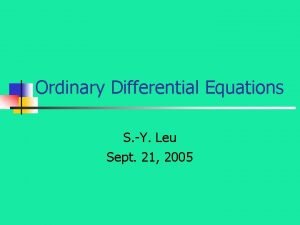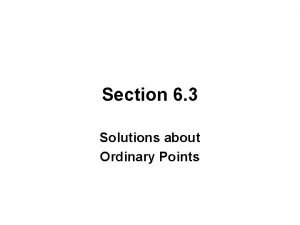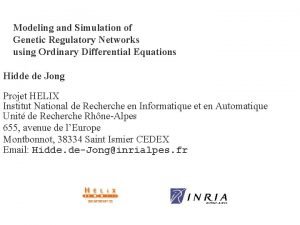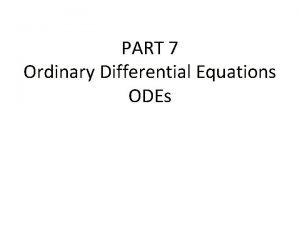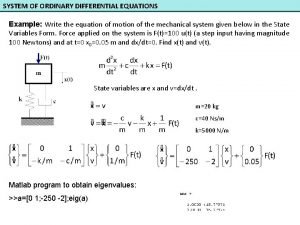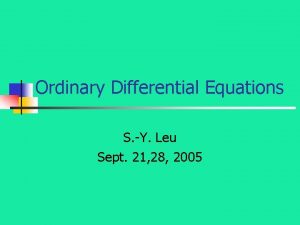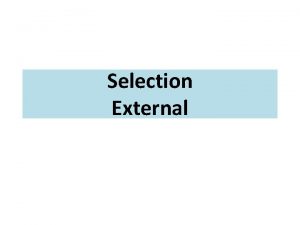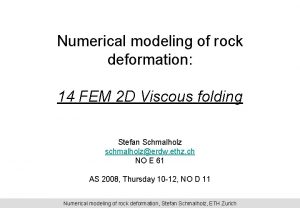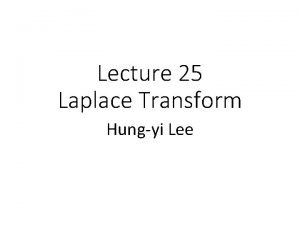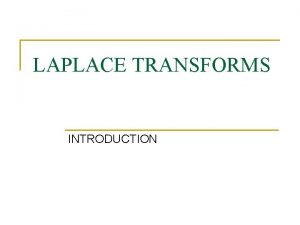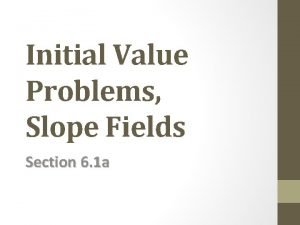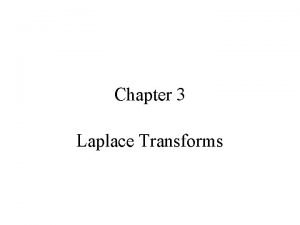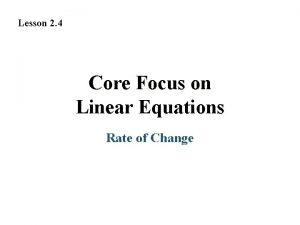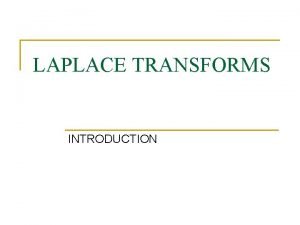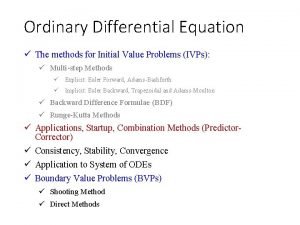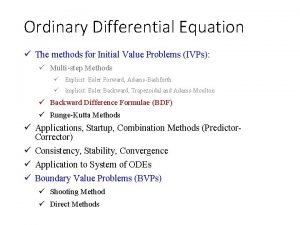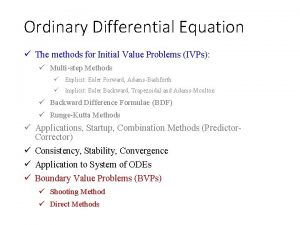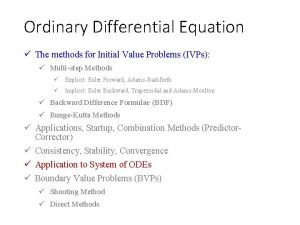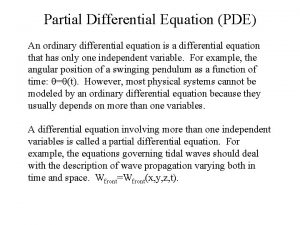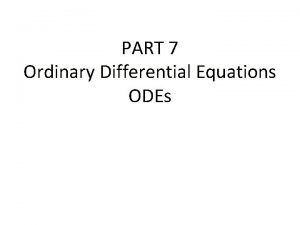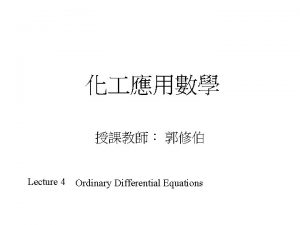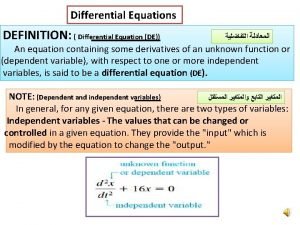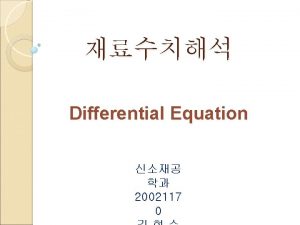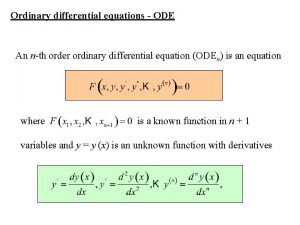Ordinary Differential Equation The methods for Initial Value























- Slides: 23

Ordinary Differential Equation ü The methods for Initial Value Problems (IVPs): ü Multi-step Methods ü Explicit: Euler Forward, Adams-Bashforth ü Implicit: Euler Backward, Trapezoidal and Adams-Moulton ü Backward Difference Formulae (BDF) ü Runge-Kutta Methods ü Applications, Startup, Combination Methods (Predictor. Corrector) ü Consistency, Stability, Convergence ü Application to System of ODEs ü Boundary Value Problems (BVPs) ü Shooting Method ü Direct Methods

Applications: Summary of Concerns ü Accuracy of the higher order multi-step and BDF methods are affected if the starting values are used from the lower order methods. ü How to start these non-self starting algorithms? ü All implicit methods (multi-step and BDF) may involve solution of non-linear equations (if f contains a nonlinear function of the dependent variable y) ü Is there a way to avoid this solution of non-linear equations? ü Numerical oscillations (instability) observed in some methods and not in some! ü Is there a way to predict and therefore, choose correct parameters for algorithm so that the numerical oscillations can be avoided? We will do Convergence Analysis!

ODE: Consistency, Stability, Convergence (Recap; Text Book S 6. 3. 2) •

Numerical Methods for IVPs: Stability •

Stability: Model Problem •

Stability: Model Problem •

Stability: Model Problem •

Stability: Multi-Step Methods (explicit) Example •

Stability: Multi-Step Methods (explicit) Example

Stability: Multi-Step Methods (explicit) Example •

Stability: Multi-Step Methods (explicit) Example

Stability: Multi-Step (Implicit) • Euler Backward method is stable everywhere outside the circle! Homework: Stability region of the Trapezoidal Method!

Stability: Multi-Step Methods (implicit) Example •

Stability: Multi-Step Methods (implicit) Example ü Euler backward method is unconditionally stable! (It is stable everywhere, where the analytical problem is also stable) ü Trapezoidal: find as homework! ü Adams-Moulton 3 rd and 4 th order methods are conditionally stable! ü Pay attention to the stability for purely imaginary λ!

Stability: BDF Methods Example •

Stability: BDF Methods Example ü For all the BDFs: Stability Region is outside the enclosed region! ü For real λ, all the BDFs are unconditionally stable! ü One can use any h without having to worry about the stability! ü Useful for stiff equations!

Stability: Runge-Kutta Methods Example •

Stability: Runge-Kutta Methods Example ü 4 th order R-K has very good stability properties (λh up to 2. 78 on the real part and 2. 83 on the imaginary part) ü The method is also stable for purely imaginary λh ü Homework: For our problem, check the stability limits of the R-K methods!

Phase Error • For periodic functions, there are phase error associated with the numerical solution. Can we quantify them?

Phase Error •

Phase Error •

Phase Error •

Arbitrary f How to choose time step h for arbitrary nonlinear f: ü Expand f in Taylor’s series around the initial condition, ü retain the first two terms (linear terms) to obtain the equivalent model problem ü set λ = coefficient of y ü compute h from the stability diagram! ü To account for the non-linearity, stay well below the stability limit!
 First order differential equations
First order differential equations Differential formula
Differential formula Ordinary point definition
Ordinary point definition Ordinary differential equations examples
Ordinary differential equations examples The initial stage of an ordinary cell thunderstorm is the
The initial stage of an ordinary cell thunderstorm is the Ordinary differential equations ppt
Ordinary differential equations ppt 1st order derivative formula
1st order derivative formula Ordinary differential equations example
Ordinary differential equations example Ordinary differential equations example
Ordinary differential equations example Euler's equation fluid mechanics
Euler's equation fluid mechanics Internal selection methods
Internal selection methods Staffing
Staffing Apa itu value creation
Apa itu value creation Cost of retained earnings
Cost of retained earnings Numerical methods for partial differential equations eth
Numerical methods for partial differential equations eth Laplace transform multiplication
Laplace transform multiplication Laplace derivative
Laplace derivative Initial value problem
Initial value problem Heaviside method
Heaviside method Initial value theorem
Initial value theorem Core focus on linear equations
Core focus on linear equations Laplace method
Laplace method Fabrication of wax pattern
Fabrication of wax pattern Slidetodoc. com
Slidetodoc. com
